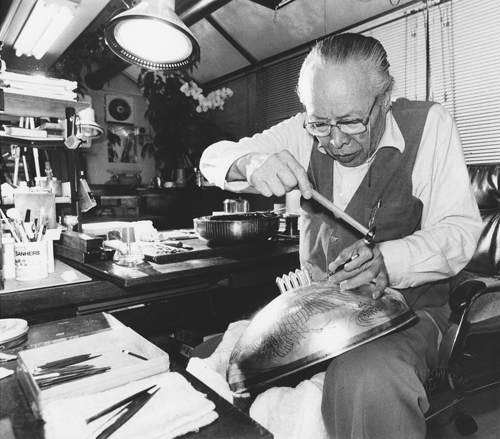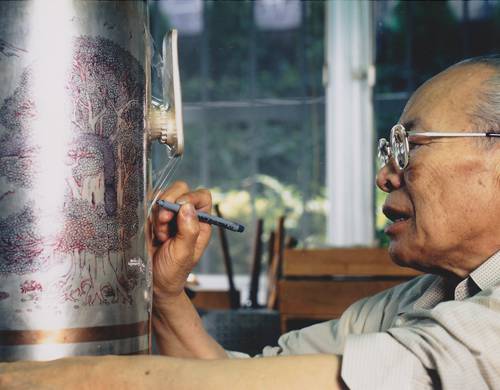History and Techniques of Metal Carving
It is deduced that the unique expression in Japanese metal carving has established since the Tumulus period.
The advent is about 6 centuries later since precious metals were brought to the northern Kyushu from the Chinese continent across the sea. The ancient metal carving produced excellent personal adornments and ornamental horse-riding gears.
Then, in the seventh century, the Buddhism culture flourished. One great piece of metal carving in this period is the Gold and Copper-made Great Kanjoban of Horyuji temple ( Kondou Dai Kanjoban).
The Japanese metal carving received much influence from Tang and Silla. When looking at gold works in Shosoin, you can find the Japanese metal carving showed significant improvement by newly adopting new techniques such as sukashibori (open work), kebori (hairline-carving), and keribori (kicking carving or wedge patterned line-carving), zogan (damascene), and nanako (fish-roe engraving).
In the next Fujiwara, Kamakura, and Muromachi periods, the Japanese metal carving shifted from planar works to usunikubori (bas-relief) and then to takanikubori (high relief). Typical works representing these periods are Keman (a Buddhist altar fitting) in Chusonji temple, Sharito (reliquary tower) in Saidaiji temple, and Great armors in Kasuga and Kushibiki Shrines, Shishibotan Koshigatana (short sword with lion and peony patterned decoration) believed to be made by Yujo.

In the Momoyama and Edo eras, the main stream of metal carving was sword decoration, and the metal carving craftsmanship produced some divergences such as Iebori (literally means house crafting), who were clan-served craftsmen folding traditions and formality in high esteem, and Machibori, (literally means town crafting), who were freelance craftsmen carving with free and novel touches.
Reflecting the peaceful days at the time, decorated swords had become adornments for Samurai. Sword guards were crafted with such decoration that life philosophy can been seen in one sword guard, and artistry in the crafted sword guards was appreciated not only among the Samurai class but also non-Samurai civilians, so that metal crafting was appraised and loved through the art of sword guards.

Metal carving is the technique of decorating the surface of a metal plate mainly by engraving with chisels, embossing, and inlaying with other metals. Materials used are copper, silver, gold, shakudo (copper-gold alloy), brass, iron, tin, lead, etc.
Kebori (hairline carving)
The name comes from carving hair-thin lines. It is a basic technique of metal carving and can carve out strong lines by using chisels with blades sharpened in triangle shapes.
Damascene (zogan)
This is a technique inlaying another metal on a metal surface. In general, gold, silver or brass is inlayed onto copper or iron.
Embossing
This is a relief-making technique for producing relief by fixing a sheet-metal made of silver, copper or the like on a pine resin platform and applying a chisel onto the surface to produce embossment, which is used to produce a relief from which the tension of metal produced by the embossment can be seen. The effect of this technique is basically different from that of clay-using relief carving.
Nunome (blanket texture pattern-making)
Using a Kiri chisel (borer chisel), blanket texture pattern is produced on a metal surface as a background pattern. (If a super-thin metal sheet or fine wires of gold, silver, or the like is inlayed thereon, it becomes nunome zogan.)
The other techniques
tensenbori (dot-line carving), keribori, katagiribori (one side cut carving), sukashibori, takanikubori, shishiaibori (relief carving below the level of the main ground of the piece), nanako, etc.

